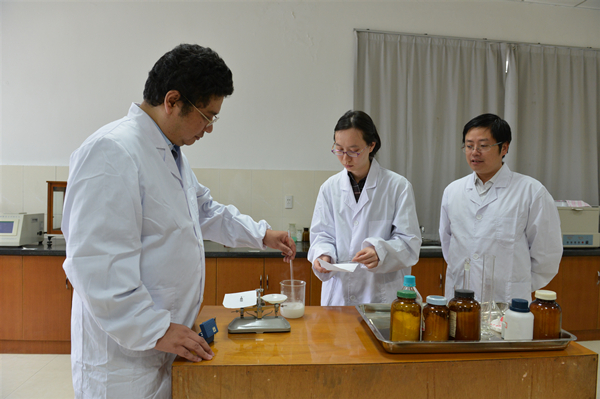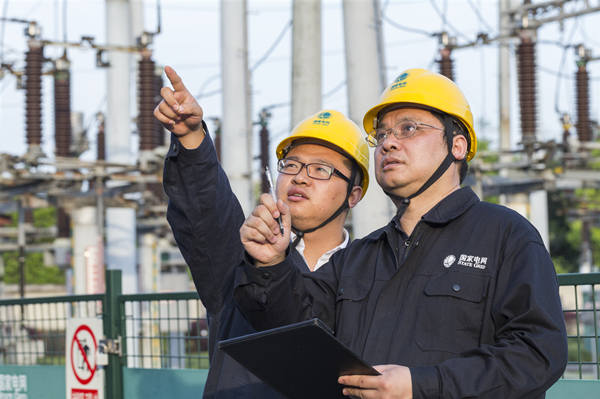Awestruck by electricity

Pan (left), an electrical technician, and his colleagues work on an experiment of anticorrosive paint for power equipment. CHINA DAILY
Technician's love for the job and knack for problem solving sparked a lifelong interest in innovation, Yang Feiyue reports.
After more than three decades of dealing with electricity, a flippant young mind has become a versatile and innovative leader in the field.
Pan Jianqiao is down-to-earth and laid-back with his occasional bursts of simple and honest laughter as he recounts his career as an electrical technician.
"I have gone from 'little fresh meat' to 'greasy old man'," he says half-jokingly.
A native of Pinghu city in Zhejiang province, the slightly plump 58-year-old has short black curly hair, and is dressed in a business casual outfit with a pair of silver framed glasses that hardly cover the dark circles around his eyes.
Yet, they can hide neither the glint of persistency nor unswerving determination in his eyes when he starts talking business.
Behind Pan's plain look is a curious mind and a great number of achievements.
In November, Pan was named a national model worker by the Communist Party of China Central Committee and the State Council in Beijing.
"It was my good luck and an honor to be there to receive the award," says Pan, who sounds just as excited about the moment as if it were yesterday.
Chaired by Premier Li Keqiang, the quinquennial gathering to award model workers last year honored a total of 1,689 people as national role model workers and 804 as exemplary individuals.
Pan says it feels like a dream, especially when recalling the moment.
Immediately after graduating from high school, he started working at the Pinghu power station in October 1984.
"It was definitely a far cry from what I had in mind," Pan says.
The substation where he was assigned to was in the middle of nowhere and close to an old graveyard.
The only sounds that he could hear were the buzzing from passing high-tension currents and the occasional cries of wildcats from a distance.
"I had basically nothing else to do after checking the electricity meters and all the equipment every hour," he says. The two senior workers who were working with him at the station had gotten used to the working environment and had developed reserved temperaments.
"I felt stifled, nearly out of my mind."
Just as the novelty and enthusiasm toward the new job were wearing off, a tornado helped put things into perspective for him in April 1985.
The tornado wreaked havoc in Pinghu and the substation was right in its path.
"All the telegraph poles were snapped into half, sirens and horns were blaring, and all switches tripped," Pan recalls.
When he was at a loss on what to do during the emergency, his two colleagues impressed him with their skillful and methodical handling of the accident.
"They were completely different from how I'd known them, checking the tripped switches, determining the scope of the power outage, putting forward possible solutions to the dispatchers, while making preparations for the overhaul of faulty equipment," he says.
The power supply departments worked their magic and had everything back on track in just one day. This also left a huge impression on Pan.
"When peace resumed in the substation and the whirring of the transformers became distinct, it stopped being a nuisance to me but a pleasant sound that was a bit rhythmic," Pan says.
From that moment on, he started to see the beauty of his job and decided to dig deeper.
His rekindled work enthusiasm made him find every opportunity to learn from professionals, read up on specialized books and practice his skills.
It did not take long for Pan to become an expert, and he soon made his way to be head of a new local substation that local authorities started to build in 1994.
As he was setting the standards for operating procedures, Pan immediately found a challenge posed by a truck-operated switch that was first used in the Pinghu power system. It was impossible to test electricity through the switch because of its design.
Though three flash lamps on the display panel of the enclosed switch would light up indicating that electricity was passing through, Pan found the lamp indication unreliable and that they could easily malfunction during installation and trial runs.
After consulting experienced technicians about his concerns, Pan got down to designing a self-inspection loop for the display panel.
Through trial and error, they managed to come up with a self-checking system that could examine the state of flash lamps, wires and sensors on the display panel for the truck switch.
The invention won the third prize for Zhejiang provincial quality control in 1997 and was later installed in many power stations nationwide.
The invention success sparked Pan's interest in innovation.
In 2007, Pan got his first patent. He designed a computerized system to avoid manual mistakes in operating secondary pressure plates that were used to protect high voltage equipment.
"It was complicated to frequently run those plates in the right order," he explains.
Pan studied digital processing on his own, and then developed 3D technology secondary pressure plates including eight specifications with a protection cover for different distribution boards.
With all the right operations keyed into the computer system, it could override incorrect manual operations.
"The protection cover is not able to move and thus could hold the plates in place if a mistake occurred," Pan says.
The system came into operation after six months.
In 2010, Pan developed a formula for coating that has proved effective in preventing corrosion, which is especially important in coastal areas such as Pinghu.
In January last year, Pan ingeniously applied the infrared imaging thermometer intended for industrial use onto temperature monitoring at public spaces as a pandemic control measure.
There could be relatively big discrepancies in forehead temperature readings during cold weather, and professional infrared thermometers that are used in transportation and security systems are expensive.
So, Pan got down to work on adjusting the parameters.
He first brought the industrial temperature monitoring range of up to 120 C down to the human temperature range, and factored in environmental temperatures and humidity, as well as the relation between body surface temperature and body temperature.
After days of troubleshooting and readjustments, Pan modified existing industrial infrared thermometers for urgent use during the pandemic.
To date, he has more than 20 national invention patents and over 90 utility model patents, and published two monographs in his field.
Pan's flair for innovation, especially in terms of problem solving, has landed him a trainer role at the local power station.
In 2010, the local power station invested more than 700,000 yuan ($108,850) to build a substation replica for Pan to train his proteges.
"I can set up obstacles for them to deal with," Pan says of the substation replica.
Wu Di, who has been Pan's apprentice for more than a decade, is impressed by Pan's attention to quality and details.
Even a difference in 0.01 millimeters when fine-tuning the parameters for body temperature measurements with industrial-grade infrared imaging thermometers could affect the result.
"He pulled several all-nighters modifying the parameters inch by inch, and finally worked out the best result for measuring human body temperature," Wu recalls.
The innovation greatly shortened the time required for temperature checks and helped the city fight the pandemic.
"I couldn't help but admire what he did," Wu says.
"He showed me how simple things are worth being done over and over again, how repetitive things require good work, and how ordinary tasks can be delivered through innovation."
Pan has also developed four training video series for local power workers based on his experiences, and took the initiative to digitalize standard power transformation operations.
"I have always been in awe of electricity," Pan says.
Speaking about the future, Pan says he feels as if he has been given more responsibilities after receiving the top honor for Chinese workers.
He was impressed by President Xi Jinping's call on Party committees and governments at all levels to respect and care for model workers during the November ceremony in Beijing.
Xi also called for building a high-quality workforce to adapt to the needs of a new scientific and technological revolution.
"I'll keep an eye on what's new in the field," Pan says. "After all, they are the source of innovation."
Contact the writer at yangfeiyue@chinadaily.com.cn

National model worker Pan Jianqiao (right) conducts an inspection of a power substation in Pinghu, Zhejiang province. CHINA DAILY


 Red boat spirit inspires new developments
Red boat spirit inspires new developments Zhejiang: A Decade of Progress
Zhejiang: A Decade of Progress A look at Jiaxing's H1 economic data
A look at Jiaxing's H1 economic data